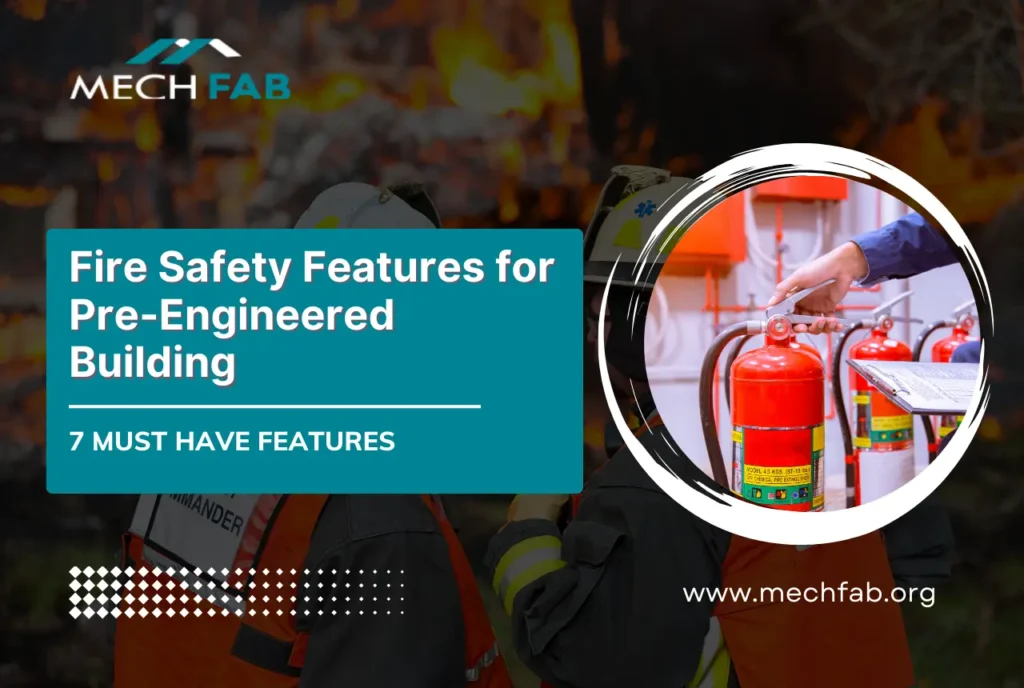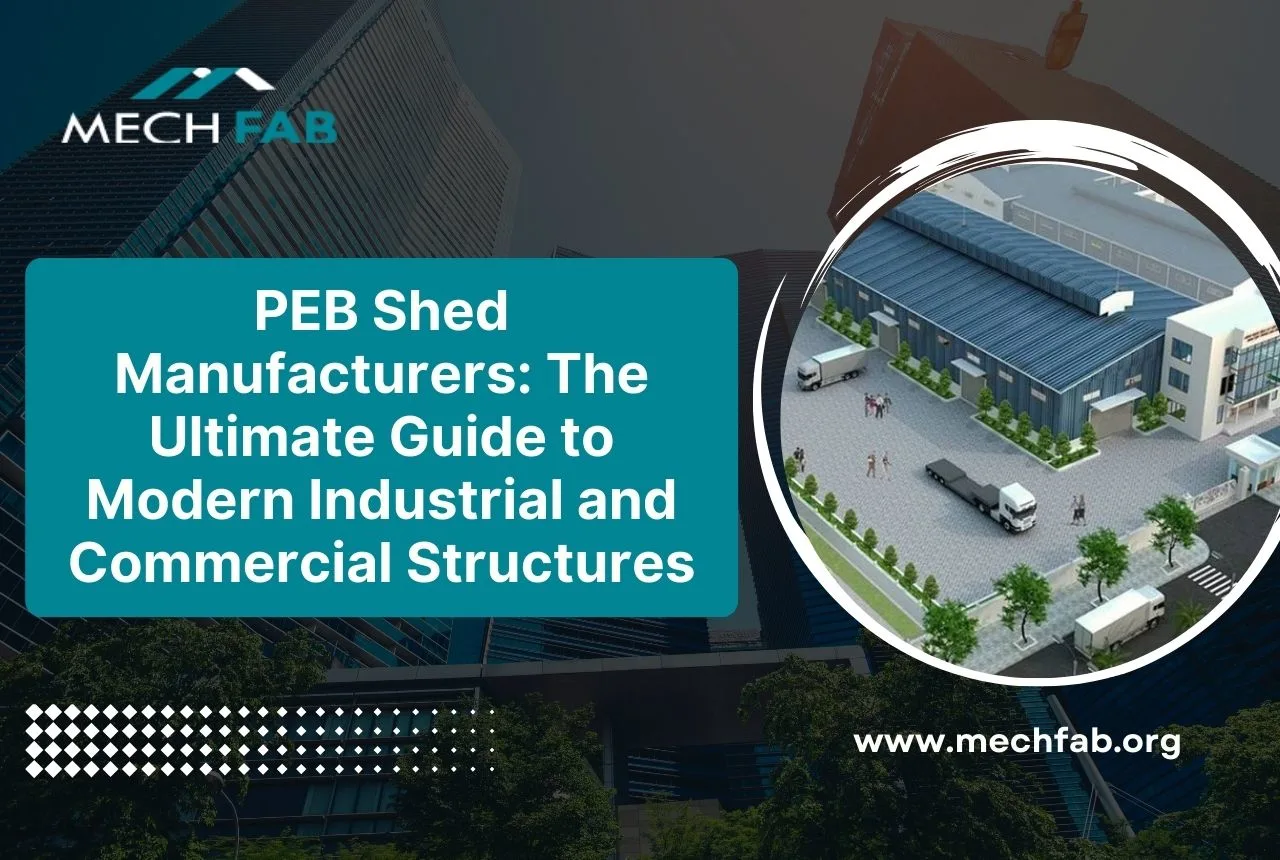Fire safety features for pre-engineered buildings are an important notion that always needs to be addressed due to the increasing popularity of PEBs. Due to the cost-effectiveness, ease of construction, and versatility that PEB structures possess, they can be used for a wide range of applications from building warehouses and factories to different commercial buildings and homes.
But there is a crucial concept regarding PEBs in the material used for their construction, that is steel. As PEBs are primarily constructed from steel, they are susceptible to heat damage during a fire outbreak.
In addition to the structure, the contents inside a PEB structure can vary greatly, which could introduce further fire hazards leading to a higher risk of fire outbreaks. These are the reasons why it is important to prioritize fire safety measures for pre-engineered buildings.
This blog article will dive into the 7 essential safety gestures that every PEB needs and should possess. When one implements the measures featured in this blog post, they can significantly reduce the risk of fire damage and truly ensure the safety of occupants and property.
7 Must-Have Fire Safety Features for Pre-Engineered Buildings
1. Fire-Resistant Building Materials
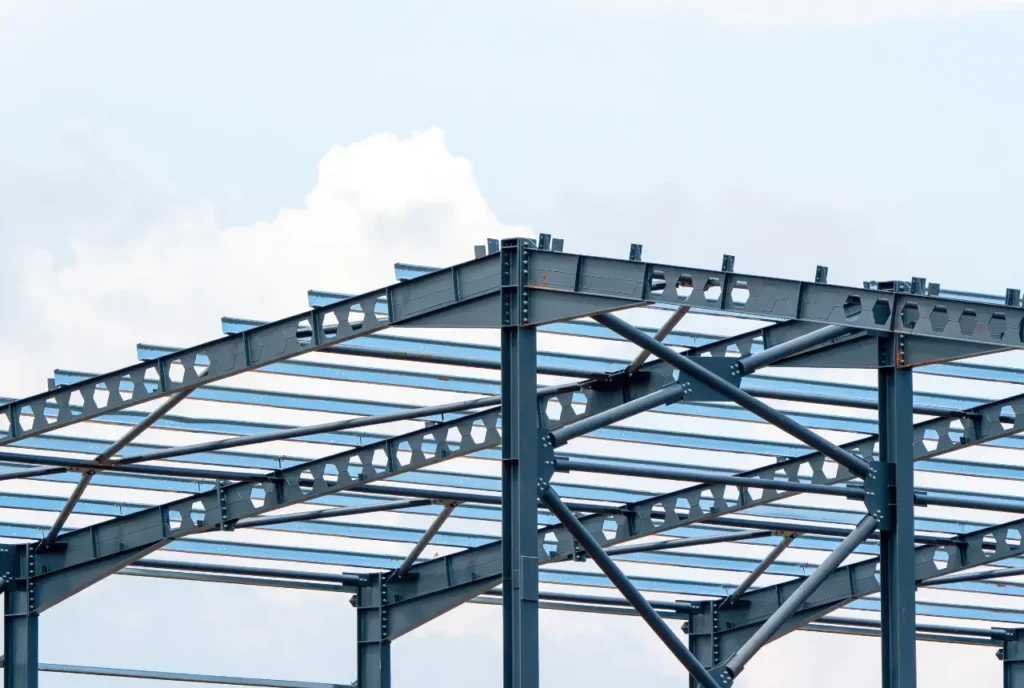
Just like many things fire safety in PEBs starts with the building materials themselves which is foundational.
It is always important to use fire-resistant materials, especially during a fire scenario, hence it becomes necessary & critical to use fire-resistant materials for the maintenance of structural integrity and preventing collapse.
When used these materials tend to delay the spread of flames and allow occupants precious time to evacuate and firefighters to contain the blaze.
Steel, the primary component of PEBs, possesses a degree of fire resistance. Nevertheless, it experiences a decrease in potency when subjected to elevated temperatures.
To resolve this issue, steel components are frequently chosen according to their specific fire resistance classifications. The steel’s ability to withstand standard fire conditions without disintegrating is typically indicated by these ratings, which are measured in hours.
Beyond the steel frame, other fire-resistant materials are frequently used in PEBs. These include:
- Fireproof Gypsum Panels: These panels consist of a gypsum core encased in non-combustible materials. They are commonly used for wall and ceiling applications, providing excellent thermal insulation and fire resistance.
- Concrete: Precast concrete panels offer outstanding fire resistance and can be used for walls, floors, and even roof systems in PEBs.
For existing PEB components that may not be inherently fire-resistant, fireproofing treatments can be applied. These treatments, often sprays or coatings, create a barrier that delays the transfer of heat and protects the underlying material.
2. Automatic Fire Alarm Systems
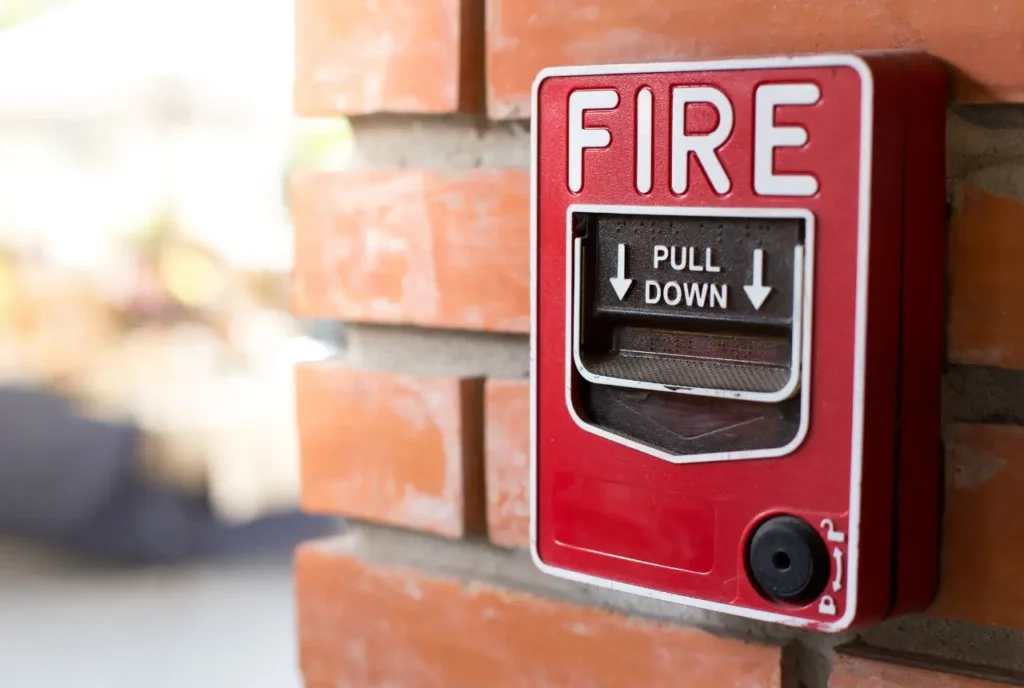
PEBs are no exception to the rule that early detection is essential in any fire protection strategy. In the event of a fire, an automatic fire alarm system serves as the initial line of defense, allowing occupants to evacuate promptly.
The sooner a fire is identified, the lower the likelihood that it will spread and pose a threat to property and life.
Several types of fire alarms are suitable for PEBs, each with its strengths:
- Smoke Detectors: These detectors are highly sensitive to airborne smoke particles, making them ideal for detecting fires that may not generate significant heat initially.
- Heat Detectors: Heat detectors, as the name suggests, are triggered by rapid increases in temperature. They are a good choice for areas prone to heat build-up, such as electrical rooms or welding areas.
- Combination Detectors: Combining smoke and heat detection technologies offers the most comprehensive fire protection. These combination models can identify fires regardless of whether they primarily produce smoke or heat.
Fire alarm systems in PEBs must be strategically positioned throughout the building to ensure optimal effectiveness. Common areas, corridors, storage rooms, and any other areas with a higher fire risk should be equipped with detectors.
It is equally crucial to conduct routine maintenance on the fire alarm system. This encompasses the regular testing and cleaning of detectors, as well as the establishment of an adequate battery reserve to guarantee uninterrupted operation.
3. Automatic Fire Suppression Systems
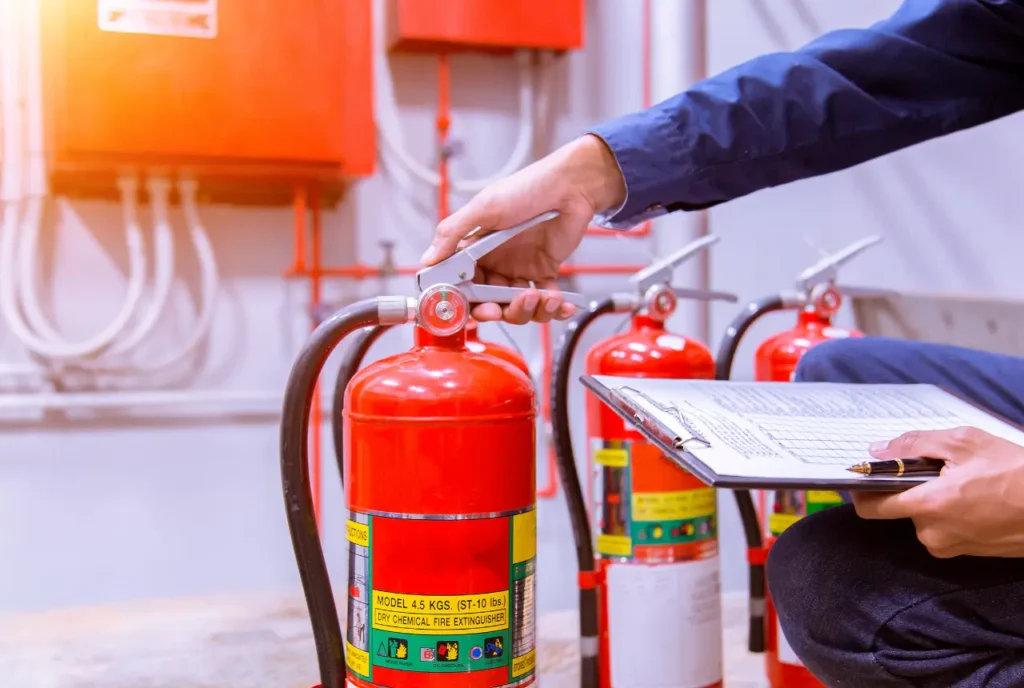
Once a fire is detected, automatic fire suppression systems take center stage in controlling the blaze and preventing its spread. These systems act swiftly and decisively, significantly reducing the risk of damage and potential loss of life.
In PEBs, two primary types of automatic fire suppression systems are commonly employed:
- Water-Based Sprinkler Systems: These traditional systems remain a highly effective fire suppression solution. A network of sprinkler heads throughout the building automatically discharges water upon fire detection, dousing the flames and preventing them from escalating. However, water damage can be a concern, so their use might be limited in areas with sensitive equipment or materials.
- Gas-Based Suppression Systems: These systems utilize clean agents such as carbon dioxide or inert gases to extinguish fires by displacing oxygen in the vicinity of the flames. Gas-based systems offer the advantage of minimal cleanup and are ideal for protecting sensitive equipment.
The selection of the most suitable fire suppression system depends on several factors specific to the PEB application. These factors include:
- Occupancy Type: The contents housed within the PEB significantly influence the fire risk. For example, a warehouse storing flammable materials might require a different system than an office space.
- Value of Contents: The value of equipment or materials stored in the PEB can influence the choice of system. For high-value assets, a clean agent gas system might be preferred to minimize potential damage.
- Environmental Considerations: Some extinguishing agents may pose environmental concerns. Selecting an environmentally friendly option might be a priority for some applications.
Consulting with a qualified fire protection professional is crucial to determine the most appropriate fire suppression system for your specific PEB needs.
4. Proper Ventilation and Compartmentation
Airflow management is indispensable in the realm of fire safety, in addition to detection and suppression. In the event of a fire, the visibility of evacuation and firefighter operations is enhanced by the removal of heat and smoke accumulation by effective ventilation systems in PEBs.
Fire compartmentation is the process of partitioning the PEB into smaller sections using fire-resistant walls and barriers.
This strategy is designed to restrict the spread of smoke and flames within the structure, thereby confining the fire to a specific area and allowing for valuable time to be allocated for response and control.
5. Fire Exit Signs and Emergency Lighting
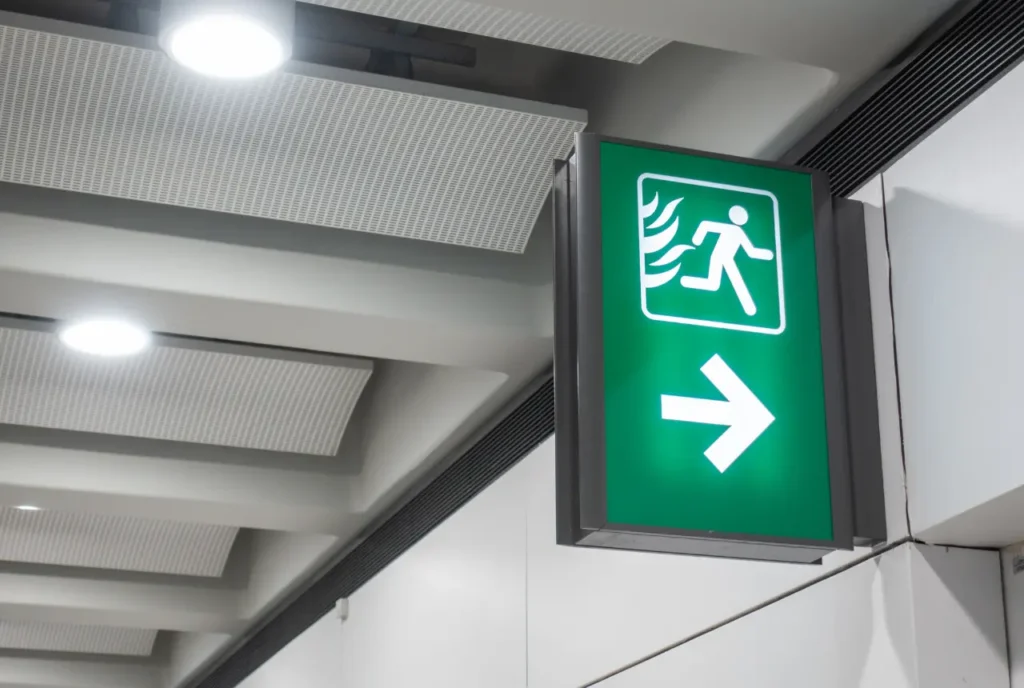
In the critical moments of a fire emergency, it is imperative to have distinct visual cues to ensure a safe evacuation. Even in low-light or smoky conditions, occupants are directed to the nearest exits by fire exit signs that are strategically located and illuminated. These signs should be either self-illuminating or backed up by emergency illumination systems.
Speaking of emergencies, a reliable emergency lighting system ensures that evacuation routes remain brightly lit even if the main power supply fails. This provides vital visibility for safe and efficient evacuation during a fire.
6. Fire Extinguishers
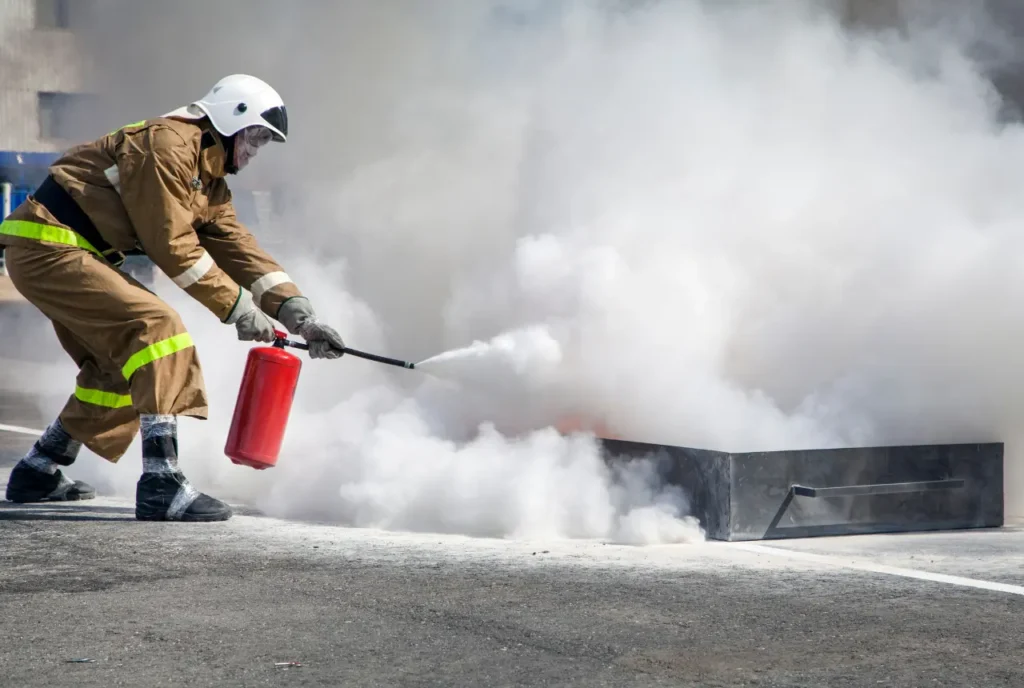
A fire extinguisher may not be made to combat major fires, but when it is readily available and properly charged can be crucial for extinguishing small fires in the early stages of a fire breakout. This in hand can make sure to prevent a minor incident from escalating into a major conflagration.
PEBs should be equipped with appropriate fire extinguishers based on the potential fire hazards. For example, Class A fire extinguishers suited for ordinary combustibles might be suitable for office areas, while Class B extinguishers designed for flammable liquids might be needed near machinery.
7. Fire Safety Training and Evacuation Plans
You are only halfway there winning the battle against fire by equipping a PEB with the necessary fire safety features. Occupant preparedness is the other half of preparation. To gain 100 percent safety is by conducting regular fire safety training that educates occupants on proper fire extinguisher use, fire alarm response, and safe evacuation procedures.
A well-defined evacuation plan, practiced through fire drills, ensures a coordinated and efficient building evacuation in the event of a fire. This plan should designate clear evacuation routes, assembly points, and roles for designated personnel like floor wardens.
Conclusion
The 7 fire safety features outlined above – fire-resistant materials, automatic fire alarms, and suppression systems, proper ventilation and compartmentation, clear fire exits and emergency lighting, readily available fire extinguishers, and a focus on occupant training and evacuation plans – form the cornerstone of a robust fire safety strategy for PEBs.
Remember, fire safety is a holistic approach. Implementing these features creates a layered defense system, from preventing fires in the first place to mitigating their spread and ensuring safe evacuation in the worst-case scenario.
For optimal fire protection in your PEB, consulting with a qualified fire safety professional is highly recommended. These experts can assess your specific needs, recommend the most suitable fire protection systems, and help you design and implement a comprehensive fire safety plan that safeguards your building, its occupants, and its contents. By prioritizing fire safety, you can achieve peace of mind and ensure the continued safe operation of your PEB.

